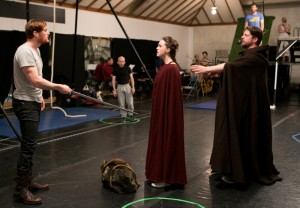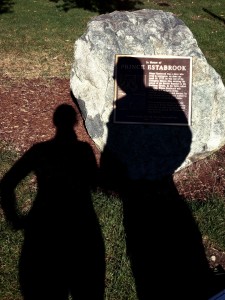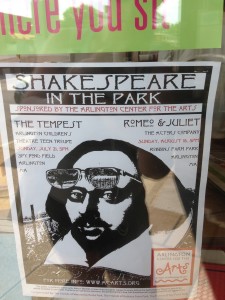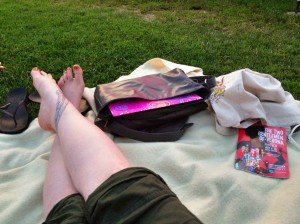And it’s finally here, my Wipeout Run Boston 5K Race Recap!
My honey and I ran the Wipeout Run because we love adventure racing and themed 5Ks. While every race has a place in our hearts, the ones with a special purpose or theme are definitely a bit more fun. We walked into this knowing that it was just going to be a nice afternoon on the course and not really expecting a hardcore running experience.
We ran in the 3PM wave. Despite the GIANT crowd of people there, we were able to get

Finish Line Jump Shot
our bibs and check in without much fuss. We checked a bag with the standard towels, extra clothes, and flip-flops, and went to wait on line for the start line. The line to the start chute was HUGE. We actually started waiting around 2:15, which I think is the only way we were running on time. I know that others who ran the race didn’t hit the course until two or three hours after their start-time. Yikes. Word to the wise: show up early, and get in line well before your time. If you wait until your sticker time, you’ll be waiting a while.
The line was in the hot sun, which wasn’t pleasant, but eventually we made our way to the start chute. The emcee who was hosting there was awesome and they played some pretty great upbeat music. It wasn’t long before we were off! (…extra props because they somehow managed to play our song just as we were hitting the start line… love when that happens!)
The first couple straight-aways were long-ish for a 5K obstacle run. They also went from flat pavement to technical gravely dirt/big rock path; not great for those with ankle problems. We were some of the few running most of the way (albeit slowly) but we took our time on those rocky paths because who wants to roll an ankle on a course like this? The first obstacle was the “Smash Wall”; a four-foot or a six-foot wall to climb over (you got to choose your height). Being Spartans, this wasn’t a big deal for us especially since they provided a step-up and a platform to step off onto. Basically you just had to step on the two-by-four, hoist yourself over, then lower down about three feet to the platform. No brainer!
After maybe a .3 mile jog, we hit the “Big Balls”. This was kind of an inflatable bouncy castle with three large red balls. You were supposed to climb up onto a platform, then leap from ball to ball to the other side. After watching the people in line ahead of me go, I recognized that maybe 1% of racers actually achieve this while everyone else wipes out spectacularly. This was the only obstacle that I felt had a serious safety hazard; it was just far too easy to hurt yourself while hurling yourself from ball to ball and coming down hard from a reasonable height (even onto an inflatable mat). Sure enough, both myself and my partner managed to do a little damage on this (even taking it easy). He found a hole in the obstacle with his foot and came down hard on pavement (though thankfully not hard enough to hurt himself, just hard enough to need a moment), and I went face first into ball number two thus cracking my back on the way down. We took it easy and grabbed some water from the nearby water station just to shake it off.
Next up were the “Tumble Tubes”; basically a water slide with an inner tube down an inflatable ramp. You grabbed your tube, climbed up, then slid down. Despite my fear of heights, this was insanely fun. The speed was just right to feel the rush but not so fast that I was worried about hurting myself. We were both laughing pretty hard at the bottom; score!
We hit the “Wrecking Balls” feeling pretty great about life. For this obstacle, everyone was required to put on a life vest (the water in the pool was about shoulder high for me; deep enough to create a safe crash zone should you get swept). Runners had to race down an inflatable balance beam being pursued by two giant red inflatable balls that were on spinning strings. I managed to nimbly dart my way across without getting tossed in the pool; honey took a dive when his ankle buckled on him. It’s best not to fight this one; it’s way safer to go in the pool than try to get back up.
After this was “The Drop” another water-slide style slide. We climbed up then slid down. It was awesome.
Just around the corner was the “Sky’s the Limit”; essentially a giant bouncy castle that you had to jump across. Let me just take a moment to tell you how much I love bouncy castles. This one was particularly awesome because 1) there were no kids to worry about hurting and 2) it was HUGE. So great!

conquering the sweeper
We hit the “Sweeper” just as the sun started to go behind a few clouds. This obstacle was kind of like the wrecking balls; basically it was run across this inflatable balance beam while a giant inflatable arm tries to sweep you. We both made it across. Let me tell you how much of a badass it makes you feel like to outrun that huge red arm.
The penultimate obstacle was the “Foam of Fury”; basically a giant slip’n’slide. You took a running leap on the inflatable gangplank, then penguined your way to the end while sprayers hit you with water and foam. Honey managed this with admirable speed; I had to kind of scoot along the last five feet or so. Next time: more of a running start.
The final obstacle was “Happy Endings”; a GIANT waterslide. We climbed those stairs feeling like a million bucks, then slid down with huge grins on our faces.
And that was that!
On the whole, this was a very fun event. I wouldn’t call it a 5K because I’m pretty sure it didn’t even hit the 2 mile mark for distance. I didn’t wear my Garmin because, as you can see, there was a fair amount of water on the course and I didn’t want to ruin any of my expensive electronics. From an administrative standpoint, they did a pretty good job of keeping things moving (even with the MASS of people there). From a safety perspective, with the exception of the one “big balls” obstacle, everything else was pretty well managed. There were marshals at every obstacle in case anyone ran into an issue, and
EMS staff was on hand to take care of emergencies. It is an expensive race (even with Groupons, our bibs were in the $65 range), and the swag isn’t great (the t-shirt you get is white cotton and boring, unless you upgrade for extra $$ to a tech t-shirt which was fine but not worth the extra $$; you don’t get a finisher’s medal unless you pay for the finisher’s medal package and race pictures are extra). The day we were running happened to be HOT right up until late afternoon; this worked to our advantage since you will get drenched on the course. Running this on a cold day would be a bit miserable. On that note, make sure you wear quick dry everything because you will get soaked. I was also particularly grateful that I had had the foresight to pack a complete change of clothes in the check bag (down to socks and underwear) since everything I was wearing was drenched by the finish line.
I think this would be an awesome race for everyone to run once with a group of friends. It is a very friendly race, so even your non-runner friends can go with you. On the whole, we’d consider running again if there were a group going; but on our own we probably wouldn’t need to have the experience a second time.












